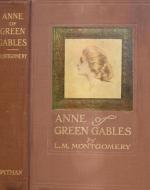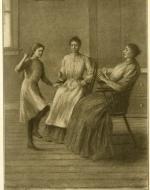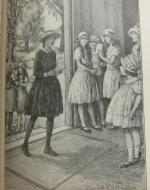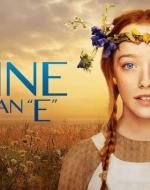Created by Georgie Svrcek on Tue, 10/15/2024 - 10:28
Description:
Anne of Green Gables (1908), despite being over a century old, is still very much a part of popular culture and the genre of children's literature. Since its initial publication, the book has been translated into 36 languages and has sold more than 50 million copies worldwide, never going out of print. Many schools around the world include it as part of their curricula, and it has a comfortable spot on many childhood (and even adult) bookshelves. Its status as a classic and an enduring book is in large part due to its ability to impart valuable lessons to children without the menace and grim quality of earlier didactic literature, as demonstrated by the distinctly non-didactic behavior of its protagonist, Anne Shirley. This exhibit will examine the qualities of the book and its main character that depart from the didactic tradition and allow Anne of Green Gables to remain relevant today, as well as the enduring tradition of Anne through one of its many adaptations that keeps the story within the cultural zeitgeist. Rather than attempting to scare children into behaving properly, Anne of Green Gables teaches children that it is okay to be different, whether that means having a big imagination or not fitting into society's normative expectations, and that mistakes are an inevitable part of learning and growing up. This positive messaging despite the book being written so long ago is what keeps audiences returning to Anne time and time again.
Book Cover of Anne of Green Gables (1908), by Lucy Maud Montgomery, illustrated by M.A. and W.A.J. Claus, 1911 edition published by Sir Isaac Pitman & Sons, courtesy of Project Gutenberg. Anne of Green Gables is the first in the series of six books chronicling the story of Anne Shirley, an orphan brought to Prince Edward Island from an orphan asylum to live with siblings Marilla and Matthew Cuthbert on their estate called Green Gables, and the trials and tribulations of her adolescent life between the ages of 11 and 16. Although initially rejected by the domineering Marilla for not being the boy she requested, Anne eventually becomes a beloved member of the family throughout the book, maturing and learning valuable lessons through experience and making many mistakes. Anne initially represents a lot of undesirable qualities for a character of the didactic tradition—incredibly talkative, active imagination, disinterest in God, vanity, among others—yet she is the protagonist of the story and is given room to improve in a way not afforded to didactic characters. And while she does lose some of those traits by the end of the book as she grows older, the Anne whom people remember and celebrate is the one who speaks her mind, has big dreams, and flies in the face of didacticism despite what the world around her (and the book) demands, which is why her story remains relevant and a staple of children's literature to this day.
"Lucy Maud Montgomery," photo c. 1930, courtesy of Library and Archives Canada. Lucy Maud Montgomery was born on November 30, 1874 in New London on Prince Edward Island in Canada to two of the province's most prominent families, the Montgomerys and the Macneills. Her mother died of tuberculosis shortly after she was born, leading her father to put her in the care of her grandparents in the nearby town of Cavendish, where she spent much of her early life. Cavendish would later serve as the basis for the fictional town of Avonlea, where Anne of Green Gables and many of her other books take place. Like her protagonist Anne Shirley, Montgomery grew up with a strong imagination and creative sensibility, often creating imaginary friends to deal with the isolation and abandonment in her personal life. She received an education in Cavendish schools before attending Prince of Wales College and obtaining a teaching license, again mirroring her famous protagonist, and though she taught for many years, her true passion was writing. Over the course of her career, Montgomery wrote 20 novels, including the nine-part Anne of Green Gables series, along with over 500 short stories, many of which were not formally published until after her death in 1942. Though much of her life was colored by sorrow and difficulty, such as caring for her mentally ill husband Ewan and the death of her second son at birth, Montgomery's writing, with its strong characters and evocative setting, remains a mainstay of Canadian culture and children's literature as a whole to this day.
Claus, M. A., & Claus, W. A. J. "'I hate you,' she cried in a choked voice, stamping her foot on the floor," for Anne of Green Gables (1908), by Lucy Maud Montgomery. This image is the second out of seven illustrations done by married couple M. A. (Mary Austin) and W. A. J. (William Anton Joseph) Claus for the original edition of Anne of Green Gables. The scene depicts Anne, Marilla, and Mrs. Rachel Lynde, who comes to Green Gables from next door to see the child that Marilla and Matthew have taken in. Upon seeing her for the first time, Mrs. Lynde proclaims Anne to be "terrible skinny and homely" with too many freckles and "hair as red as carrots," all of which Anne finds incredibly insulting. As shown in the picture, Anne stomps her feet and screams at Mrs. Lynde that she hates her and throws insults back in her direction, calling her rude and impolite as well as fat and ugly. Mrs. Lynde leaves, as the chapter title says, properly horrified at Anne's behavior, and Marilla disciplines Anne at once for her disrespect by sending her to her room and not permitting her to leave until she is ready to apologize. Anne eventually does apologize to Mrs. Lynde, and this scene is the first time in the book that Anne is punished for her misbehavior and learns from her mistake, though it is far from the last. However, unlike in a strictly didactic text that would have preceded the writing of Anne, Anne is never made to seem like a bad child or in need of the harsh and menacing treatment of children from earlier children's literature. Instead, the book allows Anne to make mistakes that any child might, like speaking their feelings in a way that hurts someone else's, and permits her to grow from them rather than label her with an unflinching moral judgement. The book even goes so far as to have Marilla say she does not agree with Mrs. Lynde and nearly laugh in private at the thought and to have Mrs. Lynde forgive Anne and say she was too hard on her. It is precisely this gentle and forgiving quality towards Anne's mistakes within the book that has allowed it to prevail past the didactic tradition of the past.
Withington, Elizabeth R, "They Looked at Her and Whispered to Each Other," from Anne of Green Gables, 1947 edition published by L.C. Page and Publishers. This illustration depicts the scene where Anne goes to church and Sunday school for the first time, and since she goes unaccompanied by Marilla or Mrs. Lynde, she is free to adorn her hat with an array of buttercups and roses that she picks on the walk to the church and enter the building unaware of the consequences. The text states that already there were rumors around the town of the 'queer girl' that the Cuthberts adopted, but this is the first moment that Anne comes into contact with the public of Avonlea, and it is in a way that perfectly illustrates both Anne's personality and the character's place within the didactic tradition. Anne, being a child who tends to stray from the intended path, has many moments in the book where she unintentionally misbehaves, and some of them have to do with her relationship with religion; she cannot say a prayer when Marilla instructs her to because she does not know any, she finds herself bored during church service, and she decorates her hat for church in a way that Marilla calls 'ridiculous' and draws attention to herself. And while she receives a stern lecture from Marilla and has to endure the sniggering and whisperings of her fellow townsfolk (mainly the young girls as shown by the illustration), Anne still does not receive the didactic level of punishment, even when she is misbehaving in a religious context. Such conduct would not be tolerated in didactic literature, but once again, the book permits Anne to misstep in her behavior and her faith, allowing the story to remain relevant and appropriate to this day.
Promotional image for "Anne with an E" (2017-2019), created by Moira Walley-Beckett, 2017, Netflix. Because Anne of Green Gables is such an enduring and widely appealing story, there have been quite a few adaptations of the book since its original publishing, from movies to a musical and even a ballet. The most recent of these adaptations is Netflix's series Anne with an E, which initially premiered in 2017. The first of the three seasons follows much of the original plot of the book with Anne mistakenly being brought to Green Gables but eventually becoming part of the family, and it includes many of the iconic moments that people remember from the book—Marilla's brooch going missing, Anne accidentally giving Diana wine instead of cordial, and Anne breaking a slate over Gilbert Blythe's head among others. The following two seasons, while generally following the same arc of the book with Anne growing up and eventually going to Queens College, take more creative liberties with the story of Anne and deal with more mature and sometimes dark themes like racism, sexism, Indigenous oppression, bullying, and homophobia. While some critica complained that the show strays too far from the original source material, others have argued that the show made deliberate alterations to root the story of Anne in the modern consciousness. Like contemporary children's literature that teaches children about the world around them, even the negative elements, Anne with an E takes on important issues with intelligence and respect, all while maintaining the trademark charm of the original Anne, proving that it's a story that deserves a place in our current canon of children's literature.






